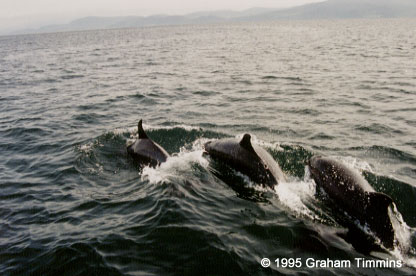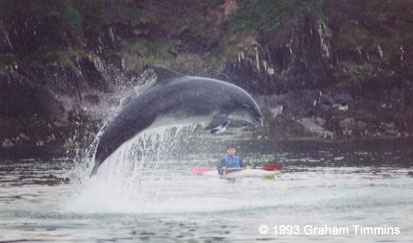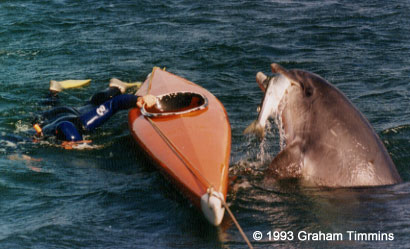 The focus of this website is on those cetaceans which particularly seek out human company. In Irish waters at this time, that means in effect bottlenose dolphins. In general these are ‘solitary’ animals, which are living alone rather than in a social group and often in a restricted area rather than moving around. Dolphins as a rule are highly gregarious and active animals, living in family groups sometimes known as pods and roaming over fairly wide tracts of ocean. Dolphin society is complex and allows for much variation. Mature males in particular may split up into ones and twos and roam far from their maternal pods, so dolphins are not always seen in groups, although that is certainly more typical around the west of Ireland. However, what is unusual is for a solo dolphin to adopt a small fixed home range. Fungie would be the extreme example of this, both in time and space, but there is an infinite gradation in dolphin 'solitariness' which may include a substantial amount of contact with other dolphins. Dony moves around a lot and has spent most of the winter in recent years with another dolphin known as Jean F'loch. Venus was only 'solitary' for a few months in 2005. Dusty spends a lot of time with human companions but also regularly meets other dolphins. It is often hard to tell just how much or how little time a dolphin spends with conspecifics; we saw tooth-rake marks on Fungie for three years before we saw him meeting other dolphins, depsite constant almost daily observation. We therefore prefer now to think in terms of interactive dolphins rather than 'solitary', 'sociable' or 'solo' dolphins. The focus of this website is on those cetaceans which particularly seek out human company. In Irish waters at this time, that means in effect bottlenose dolphins. In general these are ‘solitary’ animals, which are living alone rather than in a social group and often in a restricted area rather than moving around. Dolphins as a rule are highly gregarious and active animals, living in family groups sometimes known as pods and roaming over fairly wide tracts of ocean. Dolphin society is complex and allows for much variation. Mature males in particular may split up into ones and twos and roam far from their maternal pods, so dolphins are not always seen in groups, although that is certainly more typical around the west of Ireland. However, what is unusual is for a solo dolphin to adopt a small fixed home range. Fungie would be the extreme example of this, both in time and space, but there is an infinite gradation in dolphin 'solitariness' which may include a substantial amount of contact with other dolphins. Dony moves around a lot and has spent most of the winter in recent years with another dolphin known as Jean F'loch. Venus was only 'solitary' for a few months in 2005. Dusty spends a lot of time with human companions but also regularly meets other dolphins. It is often hard to tell just how much or how little time a dolphin spends with conspecifics; we saw tooth-rake marks on Fungie for three years before we saw him meeting other dolphins, depsite constant almost daily observation. We therefore prefer now to think in terms of interactive dolphins rather than 'solitary', 'sociable' or 'solo' dolphins.
 All dolphins tend to bow-ride boats which are going the way they want to go and in this sense may be said to associate with human beings. In some parts of the world, dolphins also feed in association with human fishing activity. Interactive dolphins, however, are distinguished by seeking out human activities which appear to have no direct benefit to them, and which in fact appear to put them into serious risk of ill health or injury. They may follow pleasure craft very closely, even when driven randomly or in circles, they may swim into shallow and polluted waters in harbours or river estuaries, and most conspicuously of all, they may approach human swimmers and divers and even allow people to touch them. All of these interactions are most definitely not normal for wild dolphins. ‘Normal’ wild dolphins may approach divers or swimmers in the water out of curiosity but nearly always pass by well underwater and out of reach. All dolphins tend to bow-ride boats which are going the way they want to go and in this sense may be said to associate with human beings. In some parts of the world, dolphins also feed in association with human fishing activity. Interactive dolphins, however, are distinguished by seeking out human activities which appear to have no direct benefit to them, and which in fact appear to put them into serious risk of ill health or injury. They may follow pleasure craft very closely, even when driven randomly or in circles, they may swim into shallow and polluted waters in harbours or river estuaries, and most conspicuously of all, they may approach human swimmers and divers and even allow people to touch them. All of these interactions are most definitely not normal for wild dolphins. ‘Normal’ wild dolphins may approach divers or swimmers in the water out of curiosity but nearly always pass by well underwater and out of reach.
 It appears that over the last 30 years there have been more and more cases of human-dolphin interactions. We don’t believe that this trend can entirely be accounted for by greater human awareness or better reporting of incidents, although it is also tempting to speculate that the dolphins may have responded to our growing interest in them by making themselves more available! The scientific community, by and large, is not interested in solitary dolphins, and especially not when they become media celebrities, precisely because these animals are atypical of the species as a whole. The leading international marine mammal on-line discussion group, MARMAM, specifically forbids mention of human-dolphin interactions in its forum (except if this takes place within a dolphinarium!). Another major forum, the European Cetacean Society, treats the sociable dolphin phenomenon only from the point of view of it being a threat to dolphins. In the general pro-dolphin arena, the Irish Whale and Dolphin Group (IWDG) and the UK Whale and Dolphin Conservation Society (WDCS) both publicly discourage anyone from interacting with wild dolphins, although many of their members and officers seem to ignore this injunction themselves in practice. Few marine biologists or conservationists will go on record, whatever they privately believe, to say that we could learn something from swimming with sociable wild dolphins - let alone that they might actually enjoy the experience themselves! It appears that over the last 30 years there have been more and more cases of human-dolphin interactions. We don’t believe that this trend can entirely be accounted for by greater human awareness or better reporting of incidents, although it is also tempting to speculate that the dolphins may have responded to our growing interest in them by making themselves more available! The scientific community, by and large, is not interested in solitary dolphins, and especially not when they become media celebrities, precisely because these animals are atypical of the species as a whole. The leading international marine mammal on-line discussion group, MARMAM, specifically forbids mention of human-dolphin interactions in its forum (except if this takes place within a dolphinarium!). Another major forum, the European Cetacean Society, treats the sociable dolphin phenomenon only from the point of view of it being a threat to dolphins. In the general pro-dolphin arena, the Irish Whale and Dolphin Group (IWDG) and the UK Whale and Dolphin Conservation Society (WDCS) both publicly discourage anyone from interacting with wild dolphins, although many of their members and officers seem to ignore this injunction themselves in practice. Few marine biologists or conservationists will go on record, whatever they privately believe, to say that we could learn something from swimming with sociable wild dolphins - let alone that they might actually enjoy the experience themselves!
In this respect, we feel the scientific community is out of step with the general public, who are obviously sold on the idea of dolphins in general and especially on getting as close to them as possible. It is also missing a great opportunity to advance our knowledge and understanding of both cetaceans and humans. Most of our scientific knowledge about the proper functioning of the human body has come from the study of disease, and in the same way the fact that interactive dolphins are not ‘normal’ does not mean that we cannot learn from them. By opting out of the debate about human-cetacean interactions, scientists leave the field clear for the adherents of the ‘messengers from the Pleiades come to save the world’ school of thought.
Sooner or later, a cross-disciplinary approach will evolve within the rigid hierarchies of academia, and marine biologists will get together with anthropologists, psychologists and social scientists to begin to unravel one of the most fascinating mysteries of the natural world, the ‘friendly’ dolphin phenomenon. When that day happens, we hope that the information collected on this website will be useful. In the meantime we are happy to remain a bunch of enthusiastic amateurs who are having a lot of fun at the same time as trying to figure out for ourselves what is going on here. We hope that reading these pages will not only provide useful and clear information, but will give a glimpse of both the enjoyment and the wonder which grips everyone who gets close to a wild cetacean.
© 2001-2006 Graham Timmins
|